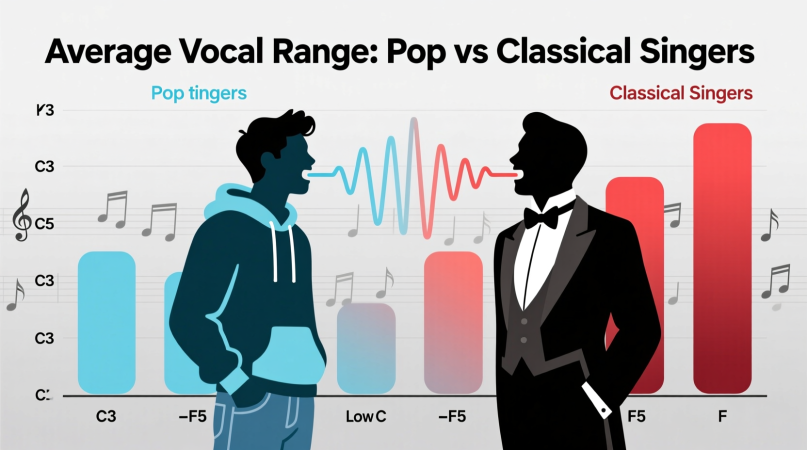
If you’ve ever compared Adele to Pavarotti or Beyoncé to Maria Callas, you might have noticed their voices feel very different. A big part of that difference comes from vocal range—the span from the lowest to the highest note a singer can produce. But how does the average vocal range of pop singers compare to that of classical singers?
What Is the Average Vocal Range in Pop Music?
Most pop singers work within 2 to 3 octaves.
- Female pop singers often cover about 2.5–3 octaves. Examples: Adele (C3–F5), Ariana Grande (~4 octaves), Billie Eilish (~2.5 octaves).
- Male pop singers usually span 2–2.5 octaves. Examples: Bruno Mars (~3 octaves), Michael Jackson (~3 octaves), Frank Sinatra (~2 octaves).
Why narrower? Pop prioritizes tone, style, and emotional connection. Songs are usually written in a singer’s comfortable tessitura (the sweet spot of their range) to ensure consistency in live performances.
What Is the Average Vocal Range in Classical Singing?
Most classical singers cover 3 to 4 octaves, sometimes more with training.
- Female classical voices (soprano, mezzo, contralto) average 3–3.5 octaves.
- Male classical voices (tenor, baritone, bass) average 2.5–3.5 octaves.
Why wider? Classical singers train to use the full voice—chest, head, and even whistle registers. They also need to project over an orchestra without microphones, which requires mastering resonance and extending range.
Examples:
- Luciano Pavarotti (tenor) – ~3 octaves
- Maria Callas (soprano) – ~3 octaves
- Jessye Norman (dramatic soprano) – ~4 octaves
Pop vs Classical: A Quick Comparison
| Style | Average Range | Focus | Examples |
|---|---|---|---|
| Pop | 2–3 octaves | Style, tone, emotional expression | Adele, Bruno Mars, Billie Eilish |
| Classical | 3–4 octaves | Full register use, projection, resonance | Pavarotti, Maria Callas, Jessye Norman |
Why the Difference Matters
- For singers: Knowing your range helps you pick songs that fit your voice and avoid strain.
- For songwriters: Understanding limits helps you write melodies that real voices can perform.
- For learners: Classical training can expand a pop singer’s range, while pop techniques can improve agility and stylistic flexibility.
👉 Curious about where your own voice fits? Try our free Vocal Range Calculator to measure your range and see which voice type you match.
FAQs About Vocal Range by Genre
Do pop singers have smaller ranges than classical singers?
Yes, on average. Pop focuses on style and accessibility, while classical emphasizes full vocal development.
Can a pop singer train to have a classical-level range?
With training, most singers can extend their range, but the timbre and style may remain genre-specific.
Is tessitura more important than vocal range?
For both genres, yes. Tessitura (where the voice is most comfortable) often matters more than extremes.
Who has the widest range overall?
In classical and experimental singing, Tim Storms holds the record with 10 octaves. In pop, Mariah Carey and Axl Rose are often noted for their unusually wide ranges.
